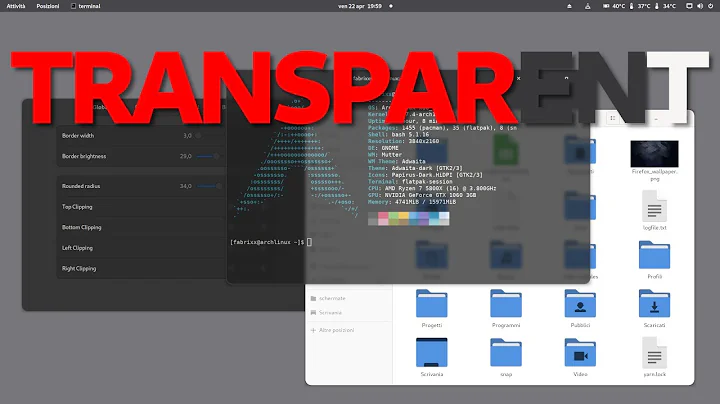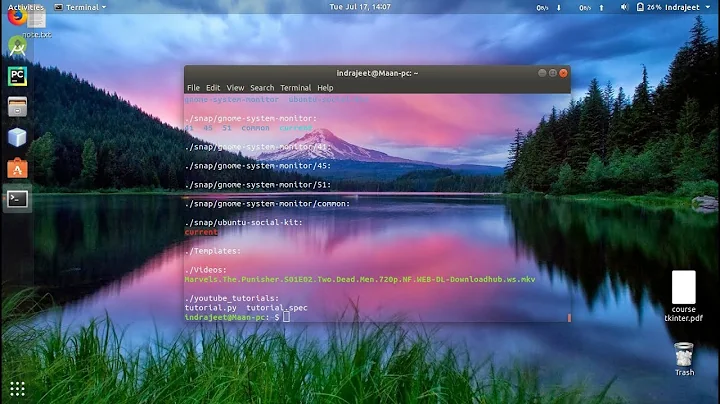How to make the Gnome Terminal transparent
To activate and change transparency settings in gnome-terminal go Edit > Profile preferences, and then go to the Colours tab. You can tick the Use transparent background box to activate transparency and slide the slider in order to change the level of transparency:
Related videos on Youtube
Syed Mohammad Ali Abidi
Updated on September 18, 2022Comments
-
 Syed Mohammad Ali Abidi over 1 year
Syed Mohammad Ali Abidi over 1 yearSo I have a dataset that looks like this:
industry<-rep(c("A","B","C","D"),4) country<-c(rep("UK",4),rep("France",4),rep("Germany",4),rep("Italy",4)) day<-c(rep(6,16),rep(7,16),rep(8,16),rep(9,16),rep(10,16)) industry<-rep(industry,5) country<-rep(country,5) a<-data.frame(industry,country) a<-data.frame(a,day) a$open<-sample(c(0,1),size = nrow(a),replace = T) a$initial_day[a$open==0]<-sample(c(3,4,5),size=nrow(a[a$open==0,]),replace = T)It looks complex but it really isn't.
+----------+---------+-----+------+-------------+ | industry | country | day | open | initial_day | +----------+---------+-----+------+-------------+ | A | UK | 6 | 1 | NA | | B | UK | 6 | 0 | 3 | | C | UK | 6 | 1 | NA | | D | UK | 6 | 0 | 3 | | A | France | 6 | 0 | 3 | | B | France | 6 | 0 | 5 | | C | France | 6 | 0 | 5 | | D | France | 6 | 1 | NA | | A | Germany | 6 | 0 | 5 | | B | Germany | 6 | 0 | 3 | +----------+---------+-----+------+-------------+Basically, I have data for 5 days (for simplicity, day 6,7,8,9 and 10), on industry closures in some different countries. And for each day, I have data on each country and each industry within each country. So 1 if it's open and 0 if it's closed. What I want to tackle is the 'initial day' column. I want to use that column to extend the data frame. This column tells you the day the industry lockdown was implemented. However, all these dates are earlier than the earliest date in the 'day' column (3,4,5). So I want to extend the data frame by creating new days and setting a 0 in between the two days.
So for instance, industry B in the UK was in lockdown on day 6, and this lockdown started on day 3. So I want to extend the data frame by setting a 0 for industry B in the UK for day 3,4, and 5. The panel needs to be balanced, so it begins on the date of the earliest initial_day lockdown. Industries that neve went into lockdown are to be '1' throughout. Does this make sense? I understand this is very unconventional but any amount of help is fully appreciated.
So it'll look like this.
+-----+---------+----------+------+--+ | day | country | industry | open | | +-----+---------+----------+------+--+ | 3 | UK | A | 1 | | | 3 | UK | B | 1 | | | 3 | UK | C | 1 | | | 3 | UK | D | 1 | | | 3 | France | A | 0 | | | 3 | France | B | 0 | | | 3 | France | C | 1 | | | 3 | France | D | 1 | | | 3 | Germany | A | 1 | | | 3 | Germany | B | 0 | | +-----+---------+----------+------+--+If, for instance, Initial day is all NA for industry B, then B in the UK never went into lockdown, so it'll be 1 throughout:
+---------+----------+------+-----+--+ | country | industry | open | day | | +---------+----------+------+-----+--+ | UK | B | 1 | 3 | | | UK | B | 1 | 4 | | | UK | B | 1 | 5 | | | UK | B | 1 | 6 | | | UK | B | 1 | 7 | | | UK | B | 1 | 8 | | | UK | B | 1 | 9 | | | UK | B | 1 | 10 | | +---------+----------+------+-----+--+If initial day is 5, meaning industry B went into lockdown on day 5, i'd need it to look like this:
+---------+----------+------+-----+--+ | country | industry | open | day | | +---------+----------+------+-----+--+ | UK | B | 1 | 3 | | | UK | B | 1 | 4 | | | UK | B | 1 | 5 | | | UK | B | 0 | 6 | | | UK | B | 0 | 7 | | | UK | B | 0 | 8 | | | UK | B | 1 | 9 | | | UK | B | 1 | 10 | | +---------+----------+------+-----+--+-
 Cettt over 3 yearsI dont understand: if look at your data where
Cettt over 3 yearsI dont understand: if look at your data wherecountry == "UK"andindustry == "B"I see thatinitial dayhas a different value for each row. -
 Syed Mohammad Ali Abidi over 3 yearsThis is a consequence of the reprex. I'm not sure how to make a reprex where these are all the same. In the actual data these will be the same. So in a sence, I'd need to pull out the first initial day value for
Syed Mohammad Ali Abidi over 3 yearsThis is a consequence of the reprex. I'm not sure how to make a reprex where these are all the same. In the actual data these will be the same. So in a sence, I'd need to pull out the first initial day value forcountry=="UK"andindustry=="B"
-
-
 muru almost 9 yearsTo clarify: The upstream version does not support transparency. This is a feature patched in.
muru almost 9 yearsTo clarify: The upstream version does not support transparency. This is a feature patched in.



![[GNOME 40] Blur Me - Blurring GTK4 Applications + Gnome Desktop](https://i.ytimg.com/vi/fqsrW-AhJKw/hq720.jpg?sqp=-oaymwEcCNAFEJQDSFXyq4qpAw4IARUAAIhCGAFwAcABBg==&rs=AOn4CLDj9iRKIN4CH_083U1dV5y6xssx2Q)



